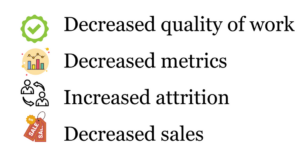A 2022 workplace report found that 60% of people reported being emotionally detached at work, and 19% identified as miserable. What is employee disengagement? Every task at work won’t be pleasant, but some employees are unhappy and disengaged from their work. So what characterizes employee disengagement?
Employee engagement is not limited to satisfaction but extends to “people personally connecting to their work and being enthusiastic and energetic around it,” as Director of People Analytics Dr. Meisha-ann Martin explains. Identifying early signs of disengagement in your employee can help you address the issue head-on.
Over half of U.S. workers feel disconnected from their work. That means some of those people could currently be in your workplace. And when employees disengage, these are the results:
Identifying early signs of disengagement in your employee can help you address the issue head-on.
Signs of Disengaged Employees
Silence
If your employee has grown unusually quiet in Slack, Teams, or other messaging apps, this is another sign of disengagement. Or maybe they have been quiet during virtual meetings. If you see this, take immediate action. Do not wait for your employee to confide in you or another manager. Initiate a conversation and figure out what’s going on.
Refusal to Defend Ideas
It’s healthy for employees to participate in brainstorming sessions and de-briefing sessions after a product or event launch or after the completion of a significant project. Another sign that your employee is disengaged is if they’ve grown apathetic to the projects, assignments, or ways of doing things. Engaged employees value collaboration, challenging and investigating processes, and sharing their opinion. This may be a sign of disengagement if you identify some apathy or “unwillingness to engage in healthy debate, just not caring enough to present or defend their ideas”(Forbes article).
Poor Communication
Poor communication is another sign that your employee is tuning out. A decreased response time or ignoring messages indicates they need to be more plugged in.
How to Respond to Disengagement
Managers can implement regular check-ins to get ahead of possible cases like this. This allows you to openly discuss with your employee where they feel disengaged and how you can work with them to feel more utilized, challenged, and valued.
Establishing a feedback culture where employees receive consistent feedback from their supervisor is helpful. When employees know where they stand with their employer and are confident they meet the standard, they are motivated to work harder.
If you identify an engagement problem in your organization, take action immediately. Most employees will not come to their employer first. So, initiate the conversation, work to understand them, and find small ways to increase their sense of value to the organization. When we work on employee engagement and employee experience, we work on productivity and sales. Which every organization would be happy to see increased.

